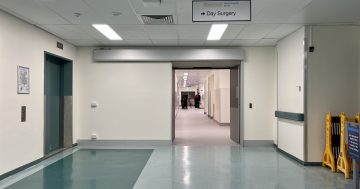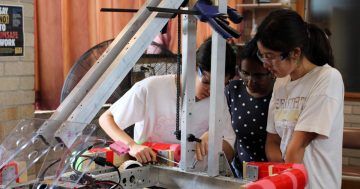Adam Triggs* says economists cannot agree on why productivity growth has not kept pace with the exponential increase in technology.

Photo: Andreas Klassen
This year marks the 40-year anniversary of the first Superman film.
Starring as Superman, Christopher Reeve fought foes and vanquished villains in an action-packed battle between good and evil.
Four decades on, Superman continues to feature in films, but often not alone.
He now stars alongside Batman, Wonder Woman, The Flash, Aquaman and other superheroes.
For the fans of DC Comics, it is a delightful coming together of childhood favourites.
But for economists, it symbolises a worrying decline in productivity.
Superman needs help
Where once a single superhero was able to save the world, now two or more are required to complete the same task.
As Oscar Wilde once said, life often imitates art.
Back when the first Superman film was released, average annual total factor productivity growth among advanced economies was almost 10 times what it fell to in 2016.
In Australia, it was three times higher in 1995–96 than in 2016–17.
Real wage growth has been close to zero in the past two years, in line with close to zero productivity growth.
But what is most striking about what has happened is when it has happened.
The past 25 years have seen extraordinary advances in technology.
We ought to be much more productive
An extra 3.5 billion people have gained access to the internet, the processing power of computers has skyrocketed, and we now have smartphones, with almost everything on them, and factories and warehouses that are automated in ways that would have once only been dreamt of.
The sharing economy promises to unlock the full potential of our idle cars, our unused bicycles and empty rooms and houses.
The accumulated history of human knowledge is at our fingertips.
So, where’s the resulting increase in productivity?
US economist Robert Solow once famously remarked that “you can see the computer age everywhere but in the productivity statistics”.
Economists have since put forward a variety of explanations for this paradox, but with little agreement.
There’s little agreement about why we’re not
Some, like 2018 Nobel Laureate William Nordhaus, point to historical data showing long lag-times between technological advances and increases in productivity.
For them, a surge in productivity is just around the corner — 10 years away, according to some estimates.
Others, like Harvard University’s Martin Feldstein, argue the paradox is driven by measurement failures.
Others argue that the productivity improvements from technology have been crowded out by other factors, like the aftershocks of the Global Financial Crisis, weak demand and investment, slowing trade, stalling growth in global value chains, ageing populations, reduced investment in education, the impacts of automation on demand and inequality, weakening competition and reduced business dynamism.
Harvard’s Marc Melitz suggests that an explanation for the paradox may lie at the firm-level.
Productivity growth might be hidden
While some organisations have been highly productive, their effects have been offset by laggard organisations.
The Organisation for Economic Cooperation and Development (OECD) found that “frontier firms” have consistently achieved productivity growth six times that of laggard organisations, which have dragged down the average.
Some attribute this to the increased prevalence of “zombie firms” — unproductive organisations kept alive by cheap money, low interest rates and nervous investors.
It’s possible to see this at the industry level.
John Fernald, from the Federal Reserve Bank of San Francisco, finds that productivity gains from information and communications technology have been concentrated in specific industries, the benefits from which have been netted-out by industries that have failed to adopt new technologies.
Northwestern University’s Robert Gordon, however, sees no paradox at all.
Or technology might be holding it back
He says, as much as we might like them, the technological advances in recent decades have been no match for the really big advances between 1870 and 1970, such as electricity and the automobile.
Harvard’s Jeff Frankel goes further.
He points to evidence suggesting the latest advances in technology might be actually cutting productivity by distracting us and reducing our attention spans.
Others are less pessimistic, but still conclude that as organisations adopt more and more new technology, the extra returns from those extra investments shrink.
With all this uncertainty, what’s the best approach for an incoming or re-elected Government?
So what should we do?
It sounds trite, but the best approach is “flexibility”.
More precisely, it is well functioning mechanisms that allow us to adjust things such as exchange rates, interest rates, government spending and industry settings.
On the whole, we have these mechanisms.
We will also need strong laws that encourage competition; that will enable new or suddenly productive organisations to displace old ones that have grown used to large market shares.
If we do turn out to be on the cusp of a new productivity surge, a flexible, competitive economy will enable us to spread the benefits quickly.
Allow good firms to grow, bad ones to die
If instead we turn out to be on track for a low productivity future, or if the productivity gains from new technology are crowded out by other effects, then flexibility can also help, redirecting resources away from inefficient firms to more efficient ones.
If it turns out the productivity paradox is no paradox at all but merely a measurement failure, then it is yet another reason to properly fund organisations such as the Australian Bureau of Statistics.
A new Government will need to watch, and to some extent it will need to wait.
But it will need to be ready.
As American economist Paul Krugman observed a generation ago when productivity growth was much higher than it is today, “productivity isn’t everything, but in the long run it is almost everything”.
* Adam Triggs is an economist and Director of Research at the Asian Bureau of Economic Research at The Australian National University. He tweets at @AdamJTriggs.
This article first appeared at theconversation.com.











